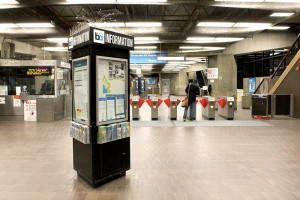BART Police Carry A Surprisingly Large Amount of Weaponry

at the Hayward BART.
BART police officers carry more weaponry in comparison to other major transit agencies, even though the trains move fewer people, an investigation by The Pioneer shows.
In comparison to BART, the New York City Subway system has a much larger ridership. Five million people ride New York’s subways every day, making it the busiest rapid transit system in the country. BART’s trains on average have a daily ridership of 400,000, but still ranks fifth in the country for daily ridership.
When officers of the NYPD are patrolling the New York City Subway system, they carry a sidearm and a nightstick. BART police officers, however, carry a sidearm, a blunt force weapon, a Taser, pepper spray and occasionally will be seen carrying a shotgun.
The Maryland Transportation Authority Police, whose primary task is patrolling toll facilities and bridges throughout that state, comes in second after BART—they carry a Glock pistol, a collapsible baton, pepper spray and a Taser.
Range Master Tim Pashoian is in charge of the weapons outfit of BART police officers. In an interview with The Pioneer, Pashoian said he didn’t think it was fair to compare the two transit systems.
“I think you have to take into perspective the differences between BART ridership and see that NYPD are not comparable,” Pashoian said. Their “circumstances” and the different factors involved were significant he said, which is what makes such a comparison unfair.
Shotguns can be used by BART police officers in long-range situations where it is more accurate than a regular sidearm, he said.
“Anytime an officer might have to use deadly force, a shotgun could be necessary,” said Pashoian.
While not a common sight, BART police officers can sometimes be seen patrolling train cars or transit stations with a shotgun across their back.
“I can almost tell you for sure, anytime an officer has a shotgun and is not using it to defend himself or take someone into custody, he is probably carrying it to a vehicle.”
Many police officers have their patrol cars parked all along the BART system, he said, and it is likely that they are transporting their shotgun back to their vehicle.
When asked if there would be an issue of intimidation for the average BART rider, he said, “No one on BART would have to worry about what officers carry as long as they are not doing something that is against the law.”
Most standard shotgun shells contain pellets that are designed to spread out when they are fired from the weapon. This increases the likelihood of hitting a target, but it can also cause accidents, as was the case in Memphis, Tenn., last November when a police officer accidentally shot another officer in the back while attempting to put down an aggressive dog during a drug bust.
Pashoian said that this was not a problem for BART police officers, saying that, “We use a brand designed to minimize spread. The brand is not designed to spread out.” The brand BART police uses is the Federal LE 13200 12 gauge buckshot, which is standard for law enforcement.
The shell that the Memphis Police Department uses is the Federal 12 gauge 00 buckshot, its weapons specialist said. This type of buckshot is designed to have less recoil, but does not have the same precision technology the shells BART uses.
The use of force is at the discretion of each individual BART officer. A verbal warning, for example, is preferred but it is not mandatory, according to the BART police policy manual.
The reasoning for this was explained by BART police spokesperson Era Jenkins.
“If you were to get up and pull a gun on me,” Jenkins said, “I wouldn’t have time to tell you to stop. I would have to pull out my gun and shoot you, because I wouldn’t have time to think to tell you to stop because you would be threatening my life and I would have to defend myself.” Taser usage is equally in the hands of an individual officer who feels it is necessary to use it.
“A Taser is an intermediate option,” Pashoian said. “It is up to a BART officer’s interpretation of the situation to decide what kind of weapon to use to contain the situation.”
There have been six shootings over the course of BART’s 40 year history, five of them resulting in death, according to BART police. The first shooting by BART police officers was in 1992 at the Hayward BART station. Jerrold Hall, 19, had allegedly stolen a cassette player and was confronted by a BART police officer.
Mike Healy, BART’s spokesperson at the time, said of the shooting, “The young man who was shot attacked the officer and then turned around and walked away. The officer’s account was that he believed he was going for a gun that he had hidden somewhere on the edge of the parking lot.”
The most recent shooting was in 2011, when BART officer James Crowell shot and killed a belligerent Charles Hill at the Civic Center station, after he allegedly threw a knife at the officer.














